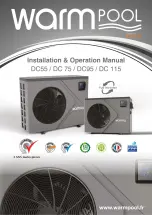
E-
17
Installing and Connecting the Drain Hose of the Indoor Unit
When installing the drain hose for the indoor unit, check if condensation draining is adequate.
When passing the drain hose through the 65-mm hole drilled in the wall, check the following:
Drain hose installation:
1
If necessary, connect the 2-meter extension drain hose to the drain hose.
2
If you use the extension drain hose, insulate the inside of the extension drain
hose with a shield.
3
Fit the drain hose into 1 of 2 drain hose holes, then fix the end of the drain
hose tightly with a clamp.
If you don’t use the other drain hose hole, block it with a rubber stopper.
4
Pass the drain hose under the refrigerant pipe, keeping the drain hose tight.
5
Pass the drain hose through the hole in the wall. Check if it slants downwards
as seen in the picture.
The hose will be fixed permanently into position after finishing
the installation and the gas leak test; refer to page 15 for further details.
Shield
Drain hose
Extension drain hose
The hose must
NOT slant upwards.
The end of the drain
hose must NOT be
placed under water.
Do NOT bend the hose
in different directions.
Keep a clearance of at
least 5cm between the
end of the hose and
the ground.
Do NOT place the end
of the drain hose in a
hollow.
5cm
less
Ditch
Rubber cap
Drain pan outlet
Drain hose
Screws hole
Screw
Changing Direction of the Drain Hose
You can select the direction of the drain hose, depending on where you want to
install the indoor unit.
1
Detach the rubber cap with the flyer.
2
Detach the drain hose by pulling it and turning to the left.
3
Insert the drain hose by fixing it into the groove of the drain hose and the
outlet of the drain pan.
4
Attach the rubber cap with a screwdriver by turning it to the right until it fixes
to the end of the groove.
One of the diagrams has an illustration with the words “Screws hole” that
should be changed to “Screw hole.”
AVXWV@@_IM_E_29819-1_4.14.09.indd 17
2009-4-14 10:15:42











































